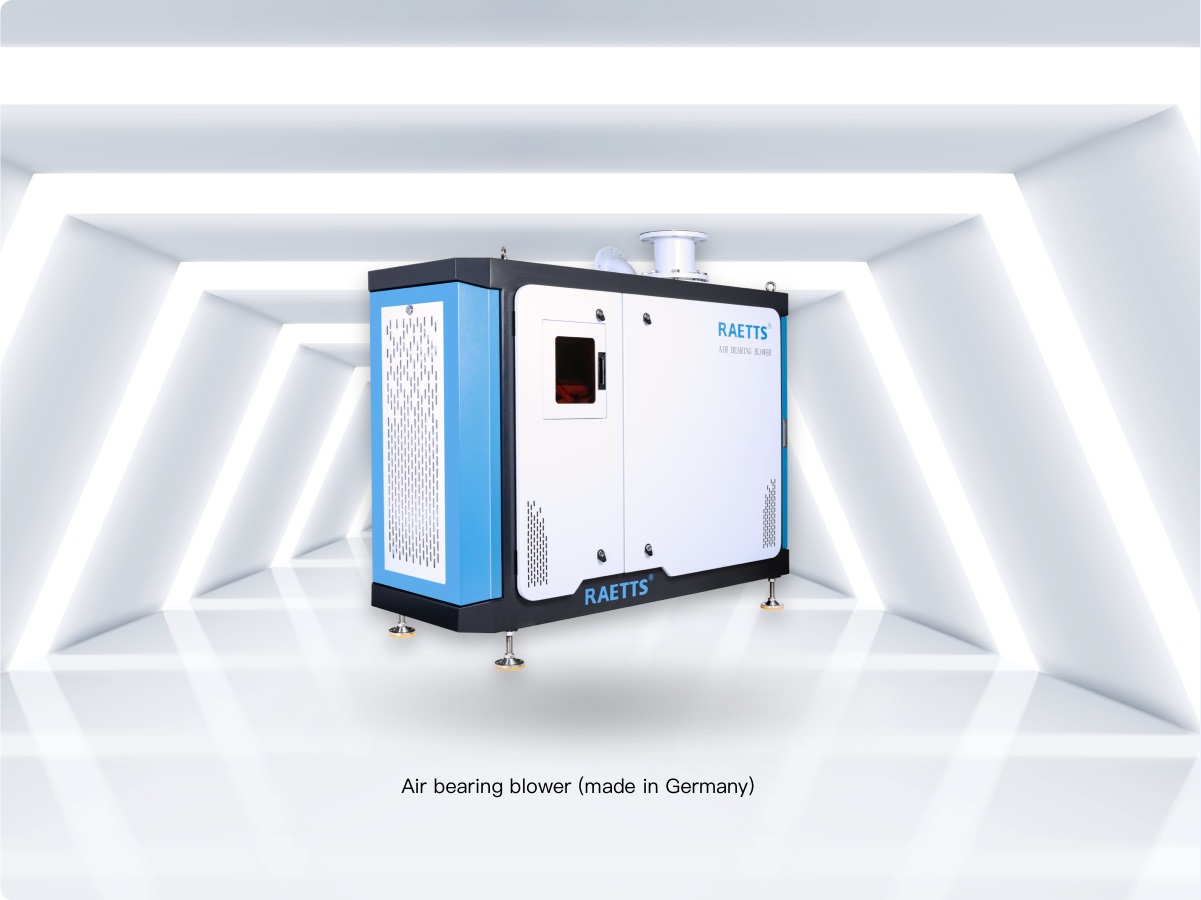In today’s industrial landscape, efficiency, reliability, and cost-effectiveness are paramount. As businesses strive to reduce operational costs and enhance productivity, the choice of blowers plays a crucial role in achieving these goals. Turbo blowers, with their innovative design and energy-saving capabilities, have emerged as a leading choice in various industries, replacing traditional blowers in many applications. RAETTS, a renowned turbo blower manufacturer, explores the key differences between turbo blowers and traditional blowers, comparing their performance, energy consumption, maintenance needs, and long-term cost benefits.
1. What Are Turbo Blowers and Traditional Blowers?
To understand the cost-benefit comparison between turbo blowers and traditional blowers, it’s important to first define each technology and its operating principle.
- Turbo Blowers: Turbo blowers are high-performance machines that use centrifugal force to generate high-pressure air. They utilize a turbocharger-style rotor design, supported by air bearings, which allow frictionless rotation. This leads to more efficient energy use, quieter operation, and extended operational lifespans.
- Traditional Blowers: Traditional blowers, also known as positive displacement blowers, operate by trapping air in a chamber and displacing it with each rotation of the rotor. These blowers use mechanical bearings and generally have higher maintenance requirements compared to turbo blowers.
2. Energy Consumption: The Key Factor in Cost Savings
One of the most significant differences between turbo blowers and traditional blowers is their energy consumption. Energy efficiency is directly linked to operational cost savings, making it a crucial consideration for businesses.
- Turbo Blowers and Energy Efficiency
Turbo blowers are engineered for high energy efficiency. The use of air bearings reduces friction, allowing the blower to operate with minimal energy loss. Additionally, many turbo blowers are equipped with Variable Speed Drives (VSDs), which adjust the blower’s speed based on real-time demand. This means that turbo blowers only consume the energy necessary for the required airflow, further optimizing energy use.
- Energy Savings: Turbo blowers can reduce energy consumption by up to 30-40% compared to traditional blowers.
- Reduced Operating Costs: With lower energy consumption, businesses can see a reduction in monthly energy bills, contributing to long-term cost savings.
- Traditional Blowers and Energy Consumption
Traditional blowers, by contrast, tend to have higher energy consumption due to the mechanical friction in their design. The use of mechanical bearings results in energy losses that can significantly impact operational efficiency, particularly over long periods of operation.
- Constant Power Draw: Traditional blowers typically run at a fixed speed, leading to continuous energy consumption, even when demand for airflow is low.
3. Maintenance Requirements: Comparing Durability and Longevity
Maintenance is another key factor when comparing the total cost of ownership for turbo blowers and traditional blowers. Minimizing downtime and reducing repair costs are crucial for ensuring consistent productivity and profitability.
- Turbo Blowers and Reduced Maintenance
Turbo blowers are known for their low maintenance requirements. The use of air bearings instead of mechanical bearings means there are fewer parts that wear out over time. This frictionless operation leads to reduced wear and tear, fewer breakdowns, and lower maintenance costs.
- Longer Service Life: With fewer mechanical parts, turbo blowers tend to have a longer service life compared to traditional blowers.
- Lower Maintenance Costs: Maintenance costs for turbo blowers are typically 50-70% lower than for traditional blowers, as they require less frequent servicing and fewer part replacements.
- Traditional Blowers and Maintenance Challenges
Traditional blowers require more frequent maintenance due to the wear on mechanical bearings and seals. These components need regular inspection, lubrication, and replacement, which increases both maintenance labor costs and parts replacement expenses.
- Higher Downtime: Because traditional blowers experience more frequent mechanical failures and require more maintenance, the downtime associated with these systems can lead to lost productivity and added costs.
4. Noise Levels and Environmental Impact
Another area of consideration when choosing between turbo blowers and traditional blowers is the noise level and environmental impact of their operation. As industries continue to focus on improving their environmental footprint, quieter and more sustainable solutions are becoming increasingly important.
- Turbo Blowers and Quiet Operation
Turbo blowers, due to their air bearing design and smooth, frictionless operation, produce significantly lower noise levels compared to traditional blowers. This is an important consideration for industries operating in noise-sensitive environments, such as wastewater treatment plants or food processing facilities.
- Noise Reduction: Turbo blowers can reduce noise pollution by up to 50%, improving the working environment and reducing the need for noise mitigation measures.
- Sustainability: In addition to energy savings, turbo blowers contribute to a greener operation by reducing noise and lowering the environmental impact.
- Traditional Blowers and Noise
Traditional blowers tend to be noisier due to the mechanical parts, particularly the bearings, which create friction and vibration. The constant mechanical noise can be disruptive to workers and surrounding environments, and often requires the implementation of soundproofing measures.
- Higher Noise Levels: Traditional blowers can generate significant noise, which may require additional costs for noise attenuation and safety precautions.
5. Initial Investment: Weighing the Upfront Costs
While turbo blowers offer numerous long-term cost benefits, their initial investment is often higher than that of traditional blowers. It’s important for businesses to consider both the short-term and long-term costs when making a purchasing decision.
- Turbo Blowers and Initial Costs
Turbo blowers typically have a higher upfront cost compared to traditional blowers due to their advanced design, air bearing technology, and integration with VSDs. However, this higher initial cost is offset by the significant savings in energy and maintenance over time.
- Long-Term Investment: The higher initial cost of turbo blowers is generally recouped through lower operating costs, energy savings, and reduced downtime.
- Return on Investment (ROI): Businesses can typically expect a return on investment within 2-3 years due to the energy and maintenance savings.
- Traditional Blowers and Initial Costs
Traditional blowers generally come with a lower upfront cost, making them more accessible for companies with limited capital. However, the ongoing energy consumption and maintenance costs can quickly negate these initial savings.
- Lower Initial Cost: While traditional blowers are more affordable initially, their higher energy consumption and maintenance costs mean they often end up being more expensive in the long run.
6. Applications and Versatility
Both turbo blowers and traditional blowers serve a wide range of industrial applications, but the choice between the two depends largely on the specific needs of the business, including air flow requirements, system size, and operational environment.
- Turbo Blowers and Versatility
Turbo blowers are highly versatile and are ideal for applications that require high air volume and consistent pressure over extended periods of time. They are particularly well-suited for industries such as wastewater treatment, pneumatic conveying, and industrial ventilation, where energy efficiency and reliability are critical.
- High-Performance Applications: Turbo blowers excel in environments where continuous, high-pressure airflow is needed, and where energy savings and long-term durability are key priorities.
- Traditional Blowers and Simpler Applications
Traditional blowers are best suited for low to medium airflow applications where cost is a more significant factor than energy efficiency. They are commonly used in smaller industrial processes, where energy efficiency and maintenance may not be as critical.
- Basic Applications: Traditional blowers work well in less demanding applications but may fall short in terms of energy savings and long-term reliability in larger, more energy-intensive operations.
The choice between turbo blowers and traditional blowers depends on a variety of factors, including energy efficiency, maintenance costs, and the specific needs of the application. At RAETTS, we are committed to providing high-performance turbo blowers that deliver long-term cost savings, reliability, and environmental benefits, ensuring that businesses get the best possible return on their investment.





